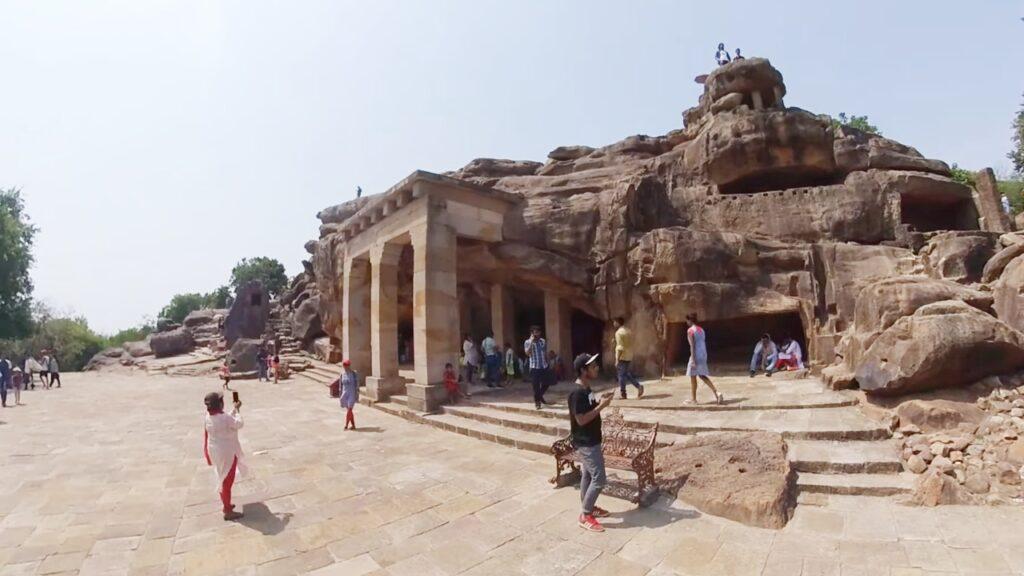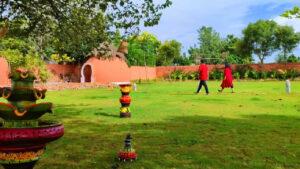About Udayagiri and Khandagiri Caves
Udayagiri and Khandagiri Caves are renowned for their historical and cultural importance, representing some of the earliest examples of Jain rock-cut architecture in eastern India. These caves were primarily excavated during the reign of King Kharavela in the 1st century BC, serving as a sanctuary for Jain monks.
- Distance (From Bhubaneswar): 9 Kms
- Trip Duration (Including Travel): 2-3 Hours
- Place Location: At Khandagiri
- Transportation Options: Cab / Auto
Architectural and Artistic Marvels
Caves are divided between two hills: Udayagiri and Khandagiri. Udayagiri, meaning “Hill of Sunrise,” contains 18 caves, including the magnificent Rani Gumpha (Queen’s Cave), known for its two-storied structure and intricate carvings of dancing women, musicians, and royal scenes. Hathi Gumpha (Cave 14) and Ganesha Gumpha (Cave 10) are also notable for their historical inscriptions and detailed sculptures.
Khandagiri, with 15 caves, features the impressive Ananta Gumpha (Cave 3), famous for its serpent carvings at the entrance. The Navamuni Gumpha (Cave 7) and Barabhuji Gumpha also house significant sculptures of Jain Tirthankaras and Sasana Devis. From the summit of Khandagiri, visitors can enjoy a splendid view of Bhubaneswar.
History Udayagiri and Khandagiri Caves
Udayagiri and Khandagiri Caves get their names from the hills they are situated on. These caves were excavated during the reign of King Kharavela in the 1st century BC and served as dwelling places for Jain monks. With a total of 33 rock-cut caves, 18 on Udayagiri hill and 15 on Khandagiri hill, these caves are a testimony to the early Jaina rock-cut architecture in eastern India.
Rani Gumpha in Udayagiri and the Ananta Gumpha in Khandagiri are particularly noteworthy for their architectural beauty and historical importance.
Udayagiri and Khandagiri Caves Timings
Udayagiri and Khandagiri Caves are open to visitors from 9 AM to 5 PM. These timings allow tourists to explore the historical site and appreciate the ancient rock-cut architecture at a leisurely pace.
Udayagiri and Khandagiri Caves Tickets
Entry tickets for the Udayagiri and Khandagiri Caves are priced as follows:
- For Indian nationals: INR 15 per person
- For foreign nationals: INR 200 per person
Interesting Facts about Udayagiri and Khandagiri Caves
- Udayagiri and Khandagiri Caves were originally built by King Kharavela, the ruler of Kalinga, during the reign of the Mauryan Empire. Caves were used as residential units for Jain monks and nuns.
- Udayagiri Caves consist of 18 caves, while the Khandagiri Caves have 15 caves. The caves are intricately carved out of the sandstone hills and feature intricate carvings and sculptures.
- Caves are known for their inscriptions, which provide valuable insights into the history and culture of ancient India. Inscriptions detail the life and achievements of King Kharavela, as well as the religious practices of the Jain monks who resided in the caves.
- Most famous cave in Udayagiri is the Rani Gumpha (Queen’s Cave), which features beautiful carvings of women and flowers. Cave is also known for its ornate doorway and pillars.
- Khandagiri caves are popular for their natural beauty and panoramic views of the surrounding landscape. Ananta cave, in particular, offers stunning views of the city of Bhubaneswar.
- Caves are a popular tourist attraction and draw visitors from all over the world. They are also frequently visited by pilgrims and devotees seeking spiritual enlightenment.
- In 1997, the caves were declared a protected monument by the Archaeological Survey of India. Efforts are being made to preserve and protect these ancient caves for future generations.
Udayagiri and Khandagiri Caves Photos









Udayagiri and Khandagiri Caves Nearby Places
- Sisupalgarh Fort – Approximately 5 km away
- Chausathi Jogini Temple – Roughly 0.1 km
- Kedareshwar Temple – About 0.1 km
- Swarnajaleswar Temple – Nearly 0.1 km
- Jayadev Vatika – Around 0.5 km
- Museum of Tribal Arts & Artifacts – Approximately 3.2 km
- Mukteswara Temple – Roughly 6.2 km
- Sri Ram Temple – About 6.4 km
- Lingaraja Temple – Nearly 5.8 km
- ISKCON Temple – Around 3.9 km
- Chandaka-Dampada Wildlife Sanctuary – Approximately 1.6 km
- Mangalajodi – Roughly 7.4 km
- Dhauli Giri Hills – About 9.7 km
Frequently Asked Questions (FAQ)
What are Udayagiri and Khandagiri Caves?
Udayagiri and Khandagiri Caves are ancient Jain rock-cut caves located near Bhubaneswar, Odisha. They are known for their historical significance and intricate carvings.
What is the best time to visit the caves?
Best time to visit is between November and February when the weather is cooler and more comfortable for exploring the caves.
Are there any entry fees for the caves?
Yes, there is an entry fee. For Indian nationals, it’s INR 15, and for foreign nationals, it’s INR 200.
What are the timings for visiting the caves?
Caves are open from 9 AM to 5 PM. It’s advisable to check for any changes in timings before your visit.
How do I reach the caves?
Caves are located about 9 km from Bhubaneswar Railway Station. You can take a cab or auto-rickshaw to reach the site.
Can I take photographs inside the caves?
Yes, photography is allowed inside the caves. There might be a separate charge for using a camera.
Are there any facilities available at the caves?
Basic facilities like parking and restrooms are available. it’s best to carry your own water and snacks.
What should I wear during my visit?
Comfortable footwear is recommended as you will need to walk and climb steps. Also, consider modest clothing out of respect for the site’s religious significance.
Udayagiri and Khandagiri caves are renowned for their multi-tiered, rock-cut architecture, which has withstood the test of time. Caves are exceptionally well-preserved, showcasing brilliant art and architecture from ancient times.
Unlike many other historical sites where carvings and sculptures have deteriorated, Udayagiri and Khandagiri retain major artworks that remain intact and accessible for exploration. Due to the complex layout of the caves, it is highly recommended to hire a guide for easier navigation and to gain deeper insights into the rich historical and cultural significance of these fascinating structures.







